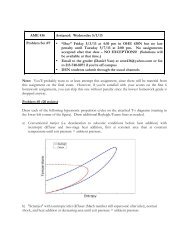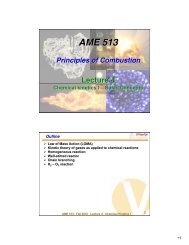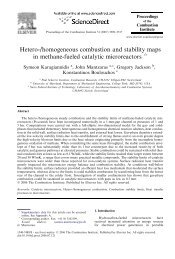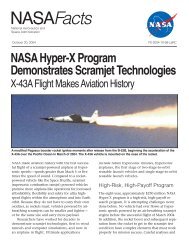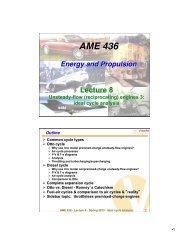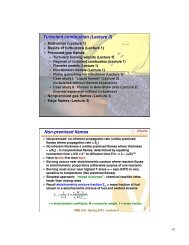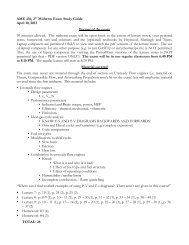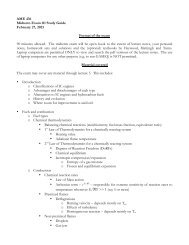AME 436 Assigned: Thursday 3/21/13 Problem Set ... - Paul D. Ronney
AME 436 Assigned: Thursday 3/21/13 Problem Set ... - Paul D. Ronney
AME 436 Assigned: Thursday 3/21/13 Problem Set ... - Paul D. Ronney
Create successful ePaper yourself
Turn your PDF publications into a flip-book with our unique Google optimized e-Paper software.
<strong>AME</strong> <strong>436</strong> <strong>Assigned</strong>: <strong>Thursday</strong> 3/<strong>21</strong>/<strong>13</strong><br />
<strong>Problem</strong> <strong>Set</strong> #4 • Due Friday 3/29/<strong>13</strong> at 4:30 pm in the drop box in OHE<br />
430N (Xerox room)<br />
• Email to the grader (Daniel Yan) at ame<strong>436</strong>@yahoo.com<br />
or fax to <strong>21</strong>3-740-8071 if you’re off campus<br />
• DEN students submit through the usual channels<br />
For all problems you can use the AirCycles.xls spreadsheet to guide your answers but you need to<br />
explain your results. Laptops or smartphones running Excel spreadsheets will NOT be permitted<br />
on the exams.<br />
<strong>Problem</strong> #1 (20 points)<br />
For a Diesel cycle with constant-pressure combustion and the following parameters: r = 20, γ = 1.3, M =<br />
0.029 kg/mole, f = 0.05, Q R = 4.0 x 10 7 J/kg, T 2 = 300K, P 2 = 1 atm, P exh = 1 atm, h = 0, η comp = η exp = 0.9<br />
(in other words, ideal except for the compression and expansion efficiency), determine the following:<br />
a) Temperature (T 3 ) and pressure (P 3 ) after compression, and the compression work per kg of mixture<br />
b) Temperature (T 4 ) after combustion and work output during combustion per kg of mixture<br />
c) Cutoff ratio ( β)<br />
d) Temperature (T 5 ) and pressure (P 5 ) after expansion, and the expansion work per kg of mixture<br />
e) Net work per kg of mixture (don’t forget the work during combustion since dV ! 0)<br />
f) Thermal Efficiency<br />
g) IMEP<br />
<strong>Problem</strong> #2 (15 points)<br />
Consider the “baseline” ideal Otto cycle shown on the P-V and T-s diagrams. Sketch modified P-V and T-s<br />
diagrams if the following changes are made. Unless otherwise noted, assume in each case the initial<br />
temperature and pressure, compression ratio, fuel mass fraction, heating value, etc. are unchanged. Where<br />
useful for clarity, label plots with phrases like “this area = that area,” “these two temperatures are the same,”<br />
etc. In some cases there may be no change to the P-V or T-s diagram.<br />
25.0<br />
20.0<br />
15.0<br />
Pressure<br />
10.0<br />
5.0<br />
1200<br />
1000<br />
800<br />
Temperature<br />
600<br />
400<br />
200<br />
0.0<br />
0<br />
0.E+00 2.E-04 Cylinder 4.E-04 volume 6.E-04 8.E-04 1.E-03 -200 0 200 Entropy 400 600 800<br />
a) There is heat loss during the constant-volume combustion but not during any other part of the cycle.
25.0<br />
20.0<br />
15.0<br />
Pressure<br />
10.0<br />
5.0<br />
1200<br />
1000<br />
800<br />
Temperature<br />
600<br />
400<br />
200<br />
0.0<br />
0.E+00 2.E-04 Cylinder 4.E-04 volume 6.E-04 8.E-04 1.E-03<br />
0<br />
-200 0 200 Entropy 400 600 800<br />
b) Due to misfire, only half the fuel burns during the usual constant-volume combustion process. The<br />
remainder of the fuel burns after part of the expansion has occurred. This second half of the fuel also<br />
burns at constant volume.<br />
25.0<br />
1200<br />
20.0<br />
15.0<br />
Pressure<br />
10.0<br />
5.0<br />
1000<br />
800<br />
Temperature<br />
600<br />
400<br />
200<br />
0.0<br />
0.E+00 2.E-04 Cylinder 4.E-04 volume 6.E-04 8.E-04 1.E-03<br />
c) The engine is taken to Planet Y, which has exactly the same fuel and atmosphere as earth but the<br />
specific heat ratio (γ) is lower on Planet Y. The compression ratio is increased so that the peak pressure<br />
is the same on earth as on Planet Y.<br />
<strong>Problem</strong> #3 (5 points)<br />
For parts (a) - (c) in problem 2, will the change to the cycle cause the brake thermal efficiency to increase,<br />
decrease or remain the same? Explain briefly.<br />
<strong>Problem</strong> #4 (15 points total)<br />
0<br />
-200 0 200 Entropy 400 600 800<br />
Recall that on Titan, one of Jupiter’s moons, is an atmosphere of pure CH 4 at 0.05 MPa (0.5 earth<br />
atmospheres) total pressure at a temperature of 250K. Deep underground are deposits of 30 mole percent<br />
O 2 and 70 mole percent N 2 that the Titans pump out of the ground. Unfortunately, most of the O 2 /N 2<br />
wells are located in politically unstable regions of Titan, so this O 2 /N 2 mixture is a valuable resource they<br />
call “fuel.” The methane in the atmosphere, which they call “air,” is “free” as far as Titans are concerned.<br />
Thermodynamic data: average mixture properties γ = 1.3, R = 300 J/kgK, C P = <strong>13</strong>00 J/kgK
CH 4 O 2 N 2 CO 2 H 2 O N<br />
Δh o f (kJ/mole) -74.87 0 0 -393.52 -241.83 +472.68<br />
Molecular weight (g/mole) 16 32 28 44 18 14<br />
K (equilibrium constant) at<br />
1800K (dimensionless)<br />
7.129 x 10 -4 1 1 2.037 x 10 3 1.873 x 10 4 3.656 x 10 -11<br />
a) Estimate the BMEP of stoichiometric premixed-charge naturally-aspirated Titan engines at wide-open<br />
throttle, with compression ratio 9. (You can use results from Homework #1 where appropriate, you<br />
don’t have to re-derive them.)<br />
b) Estimate the displacement volume (V d ) needed to obtain a 100 horsepower two-stroke engine assuming<br />
a maximum rotation speed N = 4000 rev/min.<br />
c) Would this engine be more or less likely to knock than the same engine (i.e. same compression ratio and<br />
rotation rate) on earth burning a stoichiometric methane + earth air mixture? Or would it have the<br />
same tendency to knock in both environments? No credit without explanation.<br />
d) Would this engine produce more or less NO than same engine on earth burning a stoichiometric<br />
methane + earth air mixture? No credit without explanation.<br />
<strong>Problem</strong> #5 (10 points)<br />
<strong>Ronney</strong> Oil and Gas Company claims to have developed a fuel, called PDR ® , that has all the same<br />
thermodynamic properties, transport properties, chemical reaction rate parameters, etc. as octane except<br />
that PDR ® has 10% higher heating value per unit mass than octane. If PDR ® fuel were used instead of<br />
octane, how would each of the following be affected? In particular, state whether each of the above will<br />
increase or decrease or remain constant, and by less than 10%, more than, or exactly 10% and briefly<br />
explain why. No credit without explanation.<br />
a) The thermal efficiency of an ideal Diesel cycle<br />
b) BMEP of a premixed-charge engine burning a stoichiometric mixture<br />
c) The equivalence ratio at the lean misfire limit in a premixed-charge engine<br />
<strong>Problem</strong> #6 (20 points)<br />
Two premixed-charge engines, A and B, have the same displacement volume, use the same fuel at the same<br />
equivalence ratio and are identical in every other way except:<br />
• Engine A rotates at 1000 RPM and has an intake pressure (P 1 ) of 1 atm (i.e. wide-open throttle, naturally<br />
aspirated)<br />
• Engine B rotates at 4000 RPM and has an intake pressure (P 1 ) of 0.5 atm (i.e. a throttled condition)<br />
Explain in a few words which engine, A or B, would have (as always, no credit without explanation!)<br />
a) The higher brake power<br />
b) The higher BMEP<br />
c) The higher brake thermal efficiency<br />
d) The greater tendency to knock<br />
e) The greater tendency to misfire<br />
f) The greater CO emissions
<strong>Problem</strong> #7 (15 points)<br />
Evaluate the claims made in this article:<br />
http://www.technologyreview.com/news/417918/ultra-efficient-gas-engine-passes-test/?nlid=2798&a=f<br />
In particular state:<br />
a) Is gasoline a good fuel to use for compression ignition? Why or why not?<br />
b) Is it possible that heating the fuel will make the mixture burn faster? Why or why not?<br />
c) If the mixture burns fast enough, can the efficiency be increased by 50%? Why or why not?<br />
d) Would partially oxidizing the fuel (assume this happens before injecting it into the cylinder, though the<br />
article doesn’t say where the partial oxidation occurs) increase efficiency? Why or why not?<br />
e) Is it possible for the engine in a typical small passenger vehicle (which normally gets say 35 mpg) to be<br />
improved to yield 98 mpg? Why or why not?<br />
f) Find two significant factual errors in the first paragraph of this page from TransonicCombustion’s<br />
website: http://www.tscombustion.com/autoinefficiency.html (Actually that page on company’s<br />
website doesn’t exist anymore, but there’s an archived copy at:<br />
http://web.archive.org/web/20120227045036/http://www.tscombustion.com/autoinefficiency.html)





